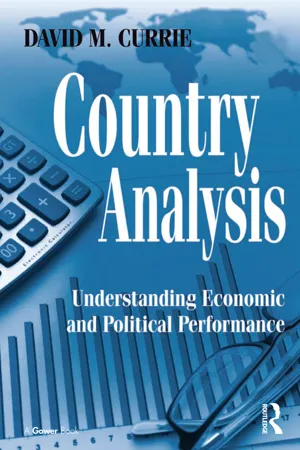Economics
Government Budget Deficit
A government budget deficit occurs when a government's spending exceeds its revenue in a given fiscal year. This shortfall is typically financed through borrowing, which can lead to an increase in the national debt. Government budget deficits can have various economic implications, including potential impacts on interest rates, inflation, and overall economic stability.
Written by Perlego with AI-assistance
Related key terms
5 Key excerpts on "Government Budget Deficit"
- eBook - ePub
- Norman Frumkin(Author)
- 2015(Publication Date)
- Routledge(Publisher)
This compares with the estimated cumulated avoided, evaded, or unpaid taxes by individuals of $132 billion, including $70 billion in offshore accounts, and $46 billion by corporations. 5 State and Local Governments The total of state and local budgets has typically been in surplus, but it fell into its largest deficit positions in 2001 and 2002 (Table 6.3). This was a shift from a budget surplus of 0.2 percent of the GDP in 2000, to a deficit of 0.3 percent of the GDP in 2001, to a deficit of 0.5 percent of the GDP in 2002. I estimate the state and local budget deficit will rise to 0.6 percent of the GDP in 2003. State and local constitutions typically require balanced budgets, so these governments are obligated to limit deficits, when they occur, to short periods. Thus, there have been strong pressures in 2002 and 2003 to cut state and local spending and/or raise taxes. It appears that if a federal law is passed in the mid-2000s creating uniform national standards for electronic on-line state sales taxes that would authorize states to collect these taxes, it would be too late to alleviate the likely deficits in the mid-2000s. In assessing prospects for future government budget surpluses or deficits, the analyst should monitor both the expenditure and receipts components of the budgets. These budget data should be considered in the context of the overall economy, as a percentage of the GDP, to give a historical perspective with previous years, and also to put the severity of a deficit into perspective. FISCAL POLICY INITIATIVES TO STIMULATE ECONOMIC GROWTH The overall effect of government budget expenditures, revenues, and the surplus/ deficit position was covered in chapter 2, “Framework for Macroeconomic Analysis and Policies.” Using that framework as a starting point, many studies have been made of the impact on economic growth of changes in federal government spending and taxes that were made over the years. 6 But the conclusions of the studies vary widely - eBook - ePub
Country Analysis
Understanding Economic and Political Performance
- David M. Currie(Author)
- 2016(Publication Date)
- Routledge(Publisher)
budget deficit ratio measures the size of the government surplus or deficit expressed as a percentage of the country’s GDP. In the US, the ratio for 2000 was:This positive result indicates a budgetary surplus; a budgetary deficit would lead to a negative result.The budget deficit ratio reflects the government’s ability to spend within the tax revenues it generates, which global investors interpret as sound fiscal policy. Just like the government spending ratio, the budget deficit ratio may be for only the central government or for all levels of government added together. The ratio above was calculated for only the central government. As you see in Table 5.10 , the US experienced an improving ratio throughout the last five years of the Clinton administration, which ended in 2000, but since then the ratio has become increasingly negative under the Bush administration.Similar data are available from the OECD, but for all levels of government – federal, state, and local in the US. Comparing the deficit as percent of GDP in Table 5.11 to deficit as percent of GDP in Table 5.10 reveals that during 1995, 1996, and 1997, when the Federal Government was running budgetary deficits, other levels of Government were running budgetary surpluses so that the ratio for general Government was positive. The same is true in 2003 through 2005: the combined Government deficits as percent of GDP are less negative than the figures for the Federal Government only, indicating that state and local governments ran budgetary surpluses.Because government’s total impact on the economy is measured by the combined taxing and spending of all levels of government, the broader indicator of general government’s surplus or deficit is more appropriate. However, it frequently is difficult to obtain timely information about all levels of government, and it certainly is difficult to evaluate decision making in all states and municipalities. For that reason, more attention is focused on behavior of decision makers at the central government level, so measures of the sort in Table 5.10 - Holley H. Ulbrich(Author)
- 2013(Publication Date)
- Routledge(Publisher)
Thinking globally. Compare the composition of spending in the US federal budget to the federal budget in Canada, which is similar to the United States in income level and federal structure. How does the spending mix differ? What factors might account for that difference?Passage contains an image 9 Borrowing, Debt Service, and Capital Financing Introduction
For the most part, courses in public sector economics leave macroeconomic issues to be addressed elsewhere. Balanced budgets, deficits, and debt are usually addressed in courses in macroeconomics as a matter of fiscal policy to influence the level of output and employment. But borrowing, debt service, and capital financing also have important microeconomic implications for the budget process, the choice of what expenditures to fund, and whether to make changes in the tax system in order to balance the budget. Those are the aspects of borrowing, debt and deficits addressed in this chapter.The deficit is the gap between spending and revenue in a particular year (a surplus if revenue exceeds spending). The debt is the cumulative result of past surpluses and deficits, the stock of government IOUs that must eventually be repaid and that generate a debt service obligation in the current year’s budget. Debt service refers to payments of interest and repayments of principal as an operating expense. Some debt service is part of the regular budget; other debt service is off-budget in special funds, including enterprise funds (like water and sewage) or agency funds (like public colleges and universities).Microeconomic and macroeconomic concerns about budget deficits cannot be separated from each other, because the state of the economy affects both revenue and expenditures, and changes in the level of revenue and expenditures (especially by the central government) in turn affect the economy. When times are good, higher income and employment generate more income tax and payroll tax revenue, and higher consumer spending generates more sales or value-added tax revenue. Even the property tax is not immune to the effects of the economy, as housing prices tend to reflect changes underlying economic conditions, although property tax revenue is more stable than income and sales tax revenue.- eBook - ePub
Macroeconomic Theory
A Dynamic General Equilibrium Approach - Second Edition
- Michael Wickens(Author)
- 2012(Publication Date)
- Princeton University Press(Publisher)
figure 5.1 , which plots government expenditures as a proportion of GDP for the United States and for the United Kingdom since 1901. Real government expenditures on goods and services and real social security benefits as a proportion of GDP have increased considerably over the last century. In 1901 they were only 2.3% of GDP for the United States and 13.5% for the United Kingdom. In most Western countries they increased from around 10–20% of GDP prior to World War I to around 40–50% after World War II. The wars themselves were the times of the greatest expansion in government expenditures. Since World War II, the shares of government expenditures in GDP have risen steadily and, apart from unemployment benefits, which vary countercyclically over the business cycle, they are not much affected by the business cycle. On average, the expenditures on goods and services and on transfers are roughly equal in size. Total government expenditures also include interest payments on government debt.Government revenues are primarily tax revenues: direct taxes on incomes and expenditure, social security taxes, and corporate taxes. The balance varies somewhat between countries, but for most developed countries direct taxes and social security taxes—which are in effect taxes on incomes—are about 60% of total tax revenue, consumption taxes are about 25%, and corporate taxes are about 10%. The average tax rate on incomes (including social security) is around 42%. Tax revenues tend to be more affected by the business cycle than expenditures. This is the main reason why government deficits tend to increase during a recession.As previously noted, governments can raise additional revenues through borrowing from the public or borrowing from the central bank, i.e., by printing money. The government simply extends its overdraft on its account with the central bank, which cashes checks issued to the public by the government.It is common in macroeconomics without microfoundations, such as Keynesian macroeconomics, to treat government expenditures as having no welfare benefits. They are included simply to allow fiscal policy to be included in the analysis and to allow the size of the fiscal multiplier to be calculated. In the standard Keynesian model this is the effect on GDP of a discretionary change in government expenditures. As this is tantamount to buying goods and services and then throwing them away—or, as Keynes himself noted, burying them— this is not a satisfactory formulation of fiscal policy. In our analysis we start by including government expenditures in the household’s utility function. We then discuss the issue of the optimal level of government expenditures. This is followed by an analysis of public finances: how best to pay for government expenditures and satisfy the government budget constraint. We also examine optimal tax policy, optimal debt, and the sustainability of fiscal deficits (the fiscal stance) in the longer term. At the end of the chapter we summarize our findings on the best way to manage fiscal policy. - eBook - ePub
- Robert Eisner(Author)
- 2010(Publication Date)
- Free Press(Publisher)
7
Deficits and the Economy:The Theory, Part II
WE HAVE SO FAR CONCENTRATED on a world in which full employment is assured—or assumed. This is a world where all who want to work are working, and are working as much as they want. It is a world where all that we can produce is produced. There is no problem of being able to sell our output. The way to increase production—and income—is therefore to increase our ability to produce, that is, to increase supply. And we have explored potential effects of deficits on supply—finding them somewhat more enigmatic than many chose to believe.But every businessman knows that getting the goods is only half the problem, if that much. What is critical is being able to sell what you can produce. For any single firm that is a problem of the demand for its products. For the economy as a whole it is a problem of total, or aggregate demand.It is here that we will find major effects of federal budget deficits and federal debt. They can have a significant impact on aggregate demand. This impact can be good or bad, depending on the situation of our changing, dynamic economy, and depending on just how large the deficits and debt really are. The latter issue brings to the fore some of the critical questions of measurement we have been discussing. But the first essential question is, however large the deficit or debt, what difference does it make? Why should the deficit—the difference between government expenditures and government tax revenues—matter?To answer this, we must build upon a body of theory and analysis well known to most economists, and indeed to a generation or two of survivors of freshman economics courses. We also have to be familiar with some of the recent reservations and objections to this theory and analysis. If we are convinced beforehand that the reservations and objections have been sufficient to negate the analysis, we have in effect decided that deficits do not matter. Those so convinced have perhaps read too far already, and might well pursue a more promising pastime. Those still concerned may want to plunge on with us into the theory.
Learn about this page
Index pages curate the most relevant extracts from our library of academic textbooks. They’ve been created using an in-house natural language model (NLM), each adding context and meaning to key research topics.




